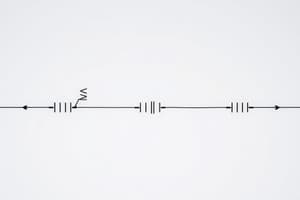Podcast
Questions and Answers
What does a V-to-I converter do?
What does a V-to-I converter do?
It converts an input voltage into a proportional output current.
What is the output current equation for a V-to-I converter?
What is the output current equation for a V-to-I converter?
Iout = Vin / R
Which of the following is a key feature of a V-to-I converter?
Which of the following is a key feature of a V-to-I converter?
- Low Output Impedance (correct)
- High Output Impedance
- High Input Impedance (correct)
- Low Input Impedance
List one application of a V-to-I converter.
List one application of a V-to-I converter.
What does an I-to-V converter do?
What does an I-to-V converter do?
What is the output voltage equation for an I-to-V converter?
What is the output voltage equation for an I-to-V converter?
Which of the following describes a key feature of an I-to-V converter?
Which of the following describes a key feature of an I-to-V converter?
Match the following converter types with their application:
Match the following converter types with their application:
Flashcards are hidden until you start studying
Study Notes
Voltage-to-Current Converter (V-to-I Converter)
- Converts input voltage into proportional output current.
- Used to drive devices requiring current input, such as LEDs, motors, and transducers.
- Uses an op-amp in inverting configuration with a feedback resistor.
- Output current is proportional to input voltage and flows through the load.
- Maintains a virtual ground at the inverting terminal to ensure current proportionality.
- Output current equation: Iout = Vin/R, where R is the feedback resistor.
- High input impedance and low output impedance.
Current-to-Voltage Converter (I-to-V Converter)
- Converts input current into proportional output voltage.
- Widely used in sensor applications where the output is in the form of current (e.g., photodiodes, current transducers).
- Uses an op-amp in inverting configuration with a feedback resistor.
- Output voltage is proportional to the input current.
- Op-amp maintains a virtual ground at the inverting terminal.
- Input current flows through the feedback resistor, developing a voltage across it.
- Output voltage equation: Vout = -Iin x Rf, where Rf is the feedback resistor.
- High accuracy, high sensitivity, and low input impedance.
Comparison of V-to-I and I-to-V Converters
- V-to-I Converter
- Converts voltage to current.
- Used for driving current-based loads like LEDs, motors.
- Op-amp in inverting configuration with load resistor.
- I-to-V Converter
- Converts current to voltage.
- Used for applications like photodiode amplifiers, current sensing.
- Op-amp in inverting configuration with feedback resistor.
Studying That Suits You
Use AI to generate personalized quizzes and flashcards to suit your learning preferences.





